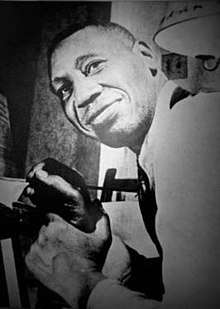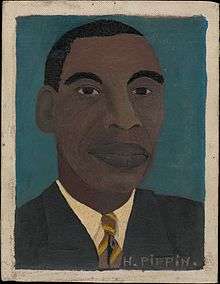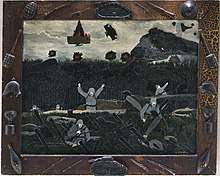Horace Pippin
Horace Pippin (February 22, 1888 – July 6, 1946) was a self-taught American artist who painted a range of themes, including scenes inspired by his service in World War I, landscapes, portraits, and biblical subjects. Some of his best-known works address the U.S.'s history of slavery and racial segregation. He was first Black artist to be the subject of a monograph, Selden Rodman's Horace Pippin, A Negro Painter in America (1947), and the New York Times eulogized him as the "most important Negro painter" in American history.[1][2] He is buried at Chestnut Grove Annex Cemetery in West Goshen Township, Chester County, Pennsylvania.[3] A Pennsylvania State historical Marker at 327 Gay Street, West Chester, Pennsylvania identifies his home at the time of his death and commemorates his accomplishments.[4]
Horace Pippin | |
|---|---|
 | |
| Born | February 22, 1888 |
| Died | July 6, 1946 (aged 58) |
| Nationality | American |
| Known for | Painting |
Early life
He was born in West Chester, Pennsylvania, on February 22, 1888, on Washington's birthday, to Harriet Pippin; his father's identity is unknown.[5] He grew up in and around Goshen, New York, but would return to West Chester in adulthood.[6] In Goshen, he attended segregated schools until he was 15, when he went to work to support his ailing mother.[7] As a boy, Horace responded to an art supply company's advertising contest and won his first set of crayons and a box of watercolors. As a youngster, Pippin made drawings of racehorses and jockeys from Goshen's celebrated racetrack.[6] Prior to his service in World War I, Pippin worked as a hotel porter, a furniture packer, and an iron moulder.[6] He was a member of St. John's African Union Methodist Protestant Church.[8] In 1920, Pippin married Jennie Fetherstone Wade Giles, who had been widowed twice and had a six-year-old-son.[6]
World War I
In World War I, Pippin served in K Company, the 3rd Battalion of the 369th infantry regiment, known for their bravery in battle as the famous Harlem Hellfighters. The predominately Black unit faced enormous racism, especially before they were transferred to the command of the French Army.[9] They were the longest serving U.S. regiment on the war's frontlines, holding their ground against enemy fire almost continuously from mid-July until the end of the war. The regiment as a whole was awarded the French Croix de Guerre. In September 1918, Pippin was shot in the right shoulder by a German sniper. The injury initially cost him the use of his arm and always limited his range of motion. He was honorably discharged in 1919. He was retroactively awarded a Purple Heart for his combat injury in 1945.[6] He said of his combat experience:
I did not care what or where I went. I asked God to help me, and he did so. And that is the way I came through that terrible and Hellish place. For the whole entire battlefield was hell, so it was no place for any human being to be.[10]
After the war, Pippin created four memoirs--one illustrated--that describe his harrowing military service in detail.[11] He returned to war subjects periodically throughout the 1930s and 1940s, and later said that WWI "brought out all the art in me".[12]
- Horace Pippin's War Notebooks, ca. 1920
 Three Soldiers on March
Three Soldiers on March Soldiers with Gas Masks in Trench
Soldiers with Gas Masks in Trench
Career

Pippin took up art in the 1920s, reportedly in part to rehabilitate his injured arm, and began painting on stretched fabric in 1930 with The End of the War: Starting Home. He later explained his creative process: "The pictures which I have already painted come to me in my mind, and if to me it is a worth while picture, I paint it."[13] He addressed a range of themes, from landscapes and still lifes to biblical subjects and political statements. Some draw on his personal experience of the war or turn-of-the-century domestic life.
He was "discovered" when he submitted two paintings to a local art show--the Chester County Art Association (CCAA) Annual Exhibition--reportedly with the aid and encouragement of various locals, including CCAA co-founders art critic Christian Brinton and artist N.C. Wyeth.[5] Brinton immediately organized a solo exhibition, cosponsored by the CCAA and the interracial West Chester Community Center, connected him with MoMA curators Dorothy Miller and Holger Cahill and, by 1940, the Philadelphia art dealer Robert Carlen and the collector Albert C. Barnes. Pippin attended art appreciation classes at the Barnes Foundation in the spring 1940 semester. Carlen, Barnes, and eventually dealer Edith Gregor Halpert played prominent roles in Pippin's career.
In the eight years between his national debut in the Museum of Modern Art's traveling exhibition “Masters of Popular Painting” (1938) and his death at the age of fifty-eight, Pippin's recognition grew exponentially across the country and internationally. During this period, he had solo exhibitions in commercial galleries in Philadelphia (1940, 1941) and New York (1940, 1944), and at the Arts Club of Chicago (1941) and San Francisco Museum of Modern Art (1942). Private collections and museums such as the Barnes Foundation, the Philadelphia Museum of Art and the Whitney Museum of American Art acquired his works. His paintings were featured in annual or biennials at the Art Institute of Chicago, Chicago, IL; Carnegie Institute, Pittsburgh, PA; Corcoran Gallery of Art, Washington, D.C.; Pennsylvania Academy of the Fine Arts, Philadelphia, PA; and the Whitney Museum of American Art, New York, as well as thematic surveys at the Dayton Art Institute, OH; National Gallery of Art, Washington, D.C.; Newark Museum, Newark, NJ; and Tate Gallery, London, UK.[5]
In the catalogue for one of his memorial exhibitions in 1947, critic Alain Locke described Pippin as "a real and rare genius, combining folk quality with artistic maturity so uniquely as almost to defy classification."
Artworks
Pippin's oeuvre includes a variety of subjects and compositional strategies. He began in the 1920s by burning designs into wood panels--mostly snow scenes--and adding paint in one or two colors to highlight specific components of the image.
His first oil painting, The Ending of the War, Starting Home, 1930-1933, depicts a scene informed by his experience at the Battle of Sechault, where he was shot.[5]. (It does not depict the official German surrender on November 11, 1918, which happened as he was recovering in a French hospital.) He painted World War I several times thereafter in the 1930s and once more in 1945. He also made the frame and decorated it with hand-carved war materiel, including German and French helmets and weapons.

Pippin painted several religious subjects, both those illustrating Bible passages and more visionary statements like his Holy Mountain series. He was a religious man, staying close to the church throughout his life by teaching Sunday school and singing in his church choir.[6]

Some of Pippin's most celebrated pictures include the three paintings of his Holy Mountain series. Reminiscent of the bucolic Peaceable Kingdom series by Quaker artist Edward Hicks, Pippin's work adds elements that contextualize the theme in his own time. Barely visible figures in the wooded backgrounds reveal forces that may precede or threaten the peace rendered in the foreground. In The Holy Mountain II and III, a brown silhouetted figure can be seen hanging among the trees, presumably a victim of lynching, which was a not uncommon atrocity in the segregated southern United States.[6] Among the paintings, soldiers, airplanes, bombs, and grave markers are also visible in the forest. Pippin suggests that discord and harmony are never too far apart. He links concepts of destruction to those of peace again by signing each painting in the series with a significant date from WWI. The Holy Mountain I is marked with "June 6", dating to D-Day. "Dec 7" marks The Holy Mountain II, signifying the attack on Pearl Harbor. Lastly, The Holy Mountain III is dated "Aug 9", the day the United Stated dropped an atomic bomb on Nagasaki, Japan.[6] In the foreground, it has been noted that the shepherd figure, which Pippin added among the animals also seen in Hicks' works, bears a striking resemblance to the artist himself.[6] Pippin's dealer Robert Carlen took credit for exposing Pippin to Hicks' series as he was a principle advocate of both self-taught artists.[5]
His Self-portrait of 1941 shows him seated at the easel. His painting of John Brown Going to his Hanging (1942) is in the collection of the Pennsylvania Academy of the Fine Arts in Philadelphia is part of a trilogy on the subject of the abolitionist who is sometimes credited with igniting the Civil War.
 Horace Pippin, John Brown Going to His Hanging
Horace Pippin, John Brown Going to His Hanging

Mr. Prejudice, made at the request of an unidentified patron, is unique in Pippin's oeuvre for its experimental composition and symbolic program. The relatively small image--about the size of a magazine cover--sorts the figures by race, with an African-American group on the left and white group on the right. The lower register reveals an assortment of military types. Some read the figure at center left, a soldier outfitted in an anachronistic WWI uniform, as Pippin himself. The black figures face forward, towards the viewer, while the white figures face left, towards the African-American group. In the painting's upper register, a white man is seen with a hammer, presumably splitting the large, golden V that surrounds him and divides the figures below. Winston Churchill coined the slogan "V for Victory" in the Allied campaign to end WWII. The slogan was expanded by African-American groups into the "Double V" campaign, which elaborated on the hope for victory abroad to include victory over discrimination and racism at home.[14] Larger figures are shown along the edges of the picture's upper register. On the left, a brown-skinned Statue of Liberty raises her torch, lighting the way to freedom. On the right, a broad figure dressed in red holds a noose in one hand, with his gaze directed at Lady Liberty. Looming above him is a hooded member of the Ku Klux Klan.[15]

Among Pippin's work there are many genre paintings, such as the Domino Game (1943), in the Phillips Collection, Washington D.C., and several versions of Cabin in the Cotton. Some, including After Supper (ca. 1935-1939) and The Milkman of Goshen (1945), relate to his childhood in New York State. The views of everyday, domestic activities both outdoors and within the home of a Northern black community that "tended to be relatively invisible to the white masses" before the Great Migration.[6] Pippin's domestic scenes thus provided a view into black people's lives of which most white patrons would have been ignorant or unaware.[6]

Pippin also created images related to popular culture, including Old Black Joe, based on the song Old Black Joe; Uncle Tom, based on the story Uncle Tom's Cabin, and maybe the musical and film Cabin in the Sky.[5] He made two portraits of the celebrated Black contralto Marian Anderson, not long after her famous 1939 concert on the steps of the Lincoln Memorial, and dedicated a painting to Paul Robeson.
Pippin left The Park Bench unfinished in his studio at this death in 1946. Romare Bearden later said: "the man, I think, symbolizes Pippin himself, who, having completed his journey and his mission, sits wistfully, in the autumn of the year, all alone on a park bench."[16]
Collections and retrospective exhibitions
Pippin painted about 140 works, many in museum collections, including the Metropolitan Museum of Art, New York, N.Y.; Hirshhorn Museum and Sculpture Garden, Washington, D.C.; Pennsylvania Academy of the Fine Arts, Philadelphia, PA; Philadelphia Museum of Art, Philadelphia, PA; The Barnes Foundation, Philadelphia, PA; the Brandywine River Museum, Chadds Ford, Pennsylvania; the Phillips Collection, Washington, D.C.; Baltimore Museum of Art, Baltimore, MD; and San Francisco Museum of Modern Art, San Francisco, CA.
Pippin was the first African American artist to be the subject of a monograph, Selden Rodman's Horace Pippin: A Negro Painter in America of 1947.[1] He has since been the subject of three major retrospective exhibitions, several scholarly books and articles, a book of poetry,[18] and several children's books.[19]
- Horace Pippin. Phillips Collection, Washington, D.C., February 25–March 1977; Terry Dintenfass Gallery, New York, April 5–30, 1977; and Brandywine River Museum of Art, Chadds Ford, Pa., June 4–September 5, 1977.
- I Tell My Heart: The Art of Horace Pippin. Pennsylvania Academy of the Fine Arts, Philadelphia, January 21–April 17, 1994; Art Institute of Chicago, April 30–July 10, 1994; Cincinnati Art Museum, July 28–October 9, 1994; Baltimore Museum of Art, October 26, 1994 – January 1, 1995; and the Metropolitan Museum of Art, February 1–April 30, 1995.
- Horace Pippin: The Way I See It. Brandywine River Museum of Art, Chadds Ford, Pa., April 25–July 19, 2015
Notes
- Rodman, Selden (1947). Horace Pippin: A Negro Painter in America. New York: Quadrangle Press.
- Conn, Steve (1997). "The Politics of Painting: Horace Pippin the Historian". American Studies. 38 (1): 5–26. ISSN 0026-3079. JSTOR 40642856.
- Holmes, Kristin E. "Horace Pippin's last resting site no longer hidden". The Philadelphia Inquirer, September 5, 2013. Retrieved April 24, 2020.
- "Horace Pippin - Pennsylvania Historical Markers on Waymarking.com". waymarking.com. Retrieved October 2, 2016.
- Monahan, Anne,. Horace Pippin : American modern. Pippin, Horace, 1888-1946. New Haven, Connecticut. ISBN 0-300-24330-8. OCLC 1111940032.CS1 maint: extra punctuation (link) CS1 maint: multiple names: authors list (link)
- Stein, Judith E. (1993). I tell my heart : the art of Horace Pippin. West, Cornel,, Wilson, Judith,, Hartigan, Lynda Roscoe,, Powell, Richard J., 1953-, Bockrath, Mark,, Buckley, Barbara. New York, NY. p. 3. ISBN 0-87663-785-3. OCLC 28148136.
- Forgey, 1977, p. 74.
- William E. Krattinger (December 2009). "National Register of Historic Places Registration: Olivet Chapel". New York State Office of Parks, Recreation and Historic Preservation. Retrieved November 21, 2010.
- Sammons, Jeffrey T. (Jeffrey Thomas), 1949-. Harlem's Rattlers and the Great War : the undaunted 369th Regiment & the African American quest for equality. Morrow, John Howard, 1944-. Lawrence, Kansas. ISBN 978-0-7006-1957-3. OCLC 864095787.CS1 maint: multiple names: authors list (link)
- "Pippin, Horace." Grolier Encyclopedia of Knowledge, volume 15, copyright 1991.
- Horace Pippin Notebook and Letters Online at the Smithsonian's Archives of American Art
- Bernier, Celeste-Marie,. Suffering and sunset : World War I in the art and life of Horace Pippin. Pippin, Horace, 1888-1946. Philadelphia. ISBN 978-1-4399-1273-7. OCLC 899114067.CS1 maint: extra punctuation (link) CS1 maint: multiple names: authors list (link)
- American folk painters of three centuries. Lipman, Jean; Armstrong, Tom; Whitney Museum of American Art. Hudson Hills Press. 1980. ISBN 0933920059.CS1 maint: others (link)
- Horace Pippin : the way I see it. Lewis, Audrey M.,, Brandywine River Museum. New York. ISBN 978-1-85759-941-1. OCLC 900609614.CS1 maint: others (link)
- Smith, Jessica T. (February 22, 2019). "Horace Pippin, Mr. Prejudice". Smarthistory. Retrieved May 1, 2020.
- Bearden, Romare (1977). Horace Pippin. Washington, D.C: The Phillips Collection.
- "Barnes Takeout: Art Talk on Horace Pippin's Supper Time". Barnes Foundation. 2 April 2020. Retrieved April 10, 2020.
- Harrington, Janice N.,. Primitive : the art and life of Horace H. Pippin : poems (First edition ed.). Rochester, NY. ISBN 978-1-942683-20-9. OCLC 940795165.CS1 maint: extra punctuation (link) CS1 maint: multiple names: authors list (link) CS1 maint: extra text (link)
- Bryant, Jen, 1960-. A splash of red : the life and art of Horace Pippin. Sweet, Melissa, 1956- (First edition ed.). New York. ISBN 978-0-375-86712-5. OCLC 775779492.CS1 maint: multiple names: authors list (link) CS1 maint: extra text (link)
Sources
- Barnes, Albert. "Horace Pippin." In Horace Pippin Exhibition, Carlen Gallery. Philadelphia, 1940.
- Bearden, Romare. "Horace Pippin." In Horace Pippin, The Phillips Collection. Washington, D.C., 1976.
- Bernier, Celeste-Marie. Suffering and Sunset: World War I in the Art and Life of Horace Pippin. Philadelphia: Temple University Press, 2015.
- Conn, Steve. "The Politics of Painting: Horace Pippin the Historian", American Studies (Spring 1997): pp. 5–26
- Forgey, Benjamin, "Horace Pippin's 'personal spiritual journey'", ARTnews 76 (Summer 1977): pp. 74-xx
- Lewis, Audrey M. Horace Pippin: The Way I See It, exh. cat. Brandywine River Museum of Art, Chadds Ford, Pa., 2015
- Locke, Alain. "Horace Pippin." In Horace Pippin Memorial Exhibition, The Art Alliance, April 8–May 4, 1947. Philadelphia, 1947.
- Monahan, Anne. Horace Pippin, American Modern. New Haven: Yale University Press, 2020.
- "Pippin, Horace." Grolier Encyclopedia of Knowledge, volume 15, copyright 1991. Grolier Inc., ISBN 0-7172-5300-7
- Rodman, Selden. Horace Pippin: A Negro Painter in America. New York: Quadrangle, 1947.
- Stein, Judith E. et al. I Tell My Heart: The Art of Horace Pippin, ex. cat. Philadelphia: Pennsylvania Academy of the Fine Arts, 1993. For the full text of Stein's essay, "An American Original," see her website "judithstein.com".
Further reading
- Bryant, Jen. A Splash of Red: The Life and Art of Horace Pippin. New York, 2013.
- Harrington, Janice N. Primitive: The Art and Life of Horace H. Pippin. BOA Editions Ltd., 2016.
External links
- Horace Pippin links
- Horace Pippin Notebook and Letters Online at the Smithsonian's Archives of American Art